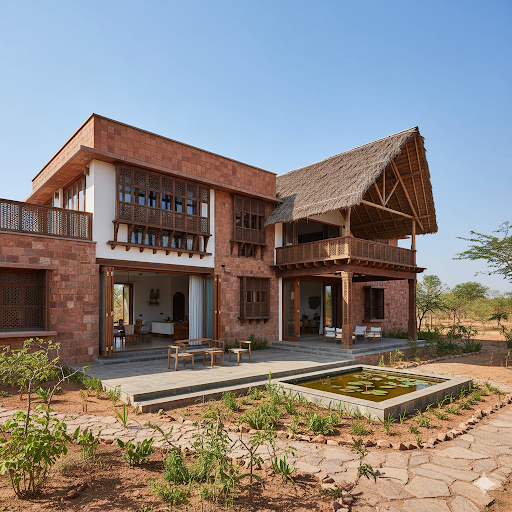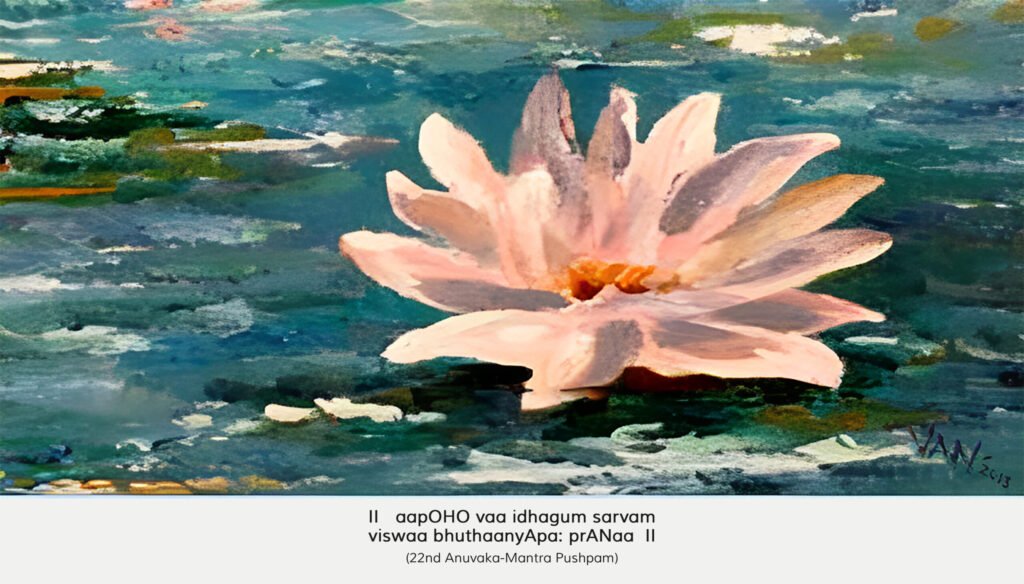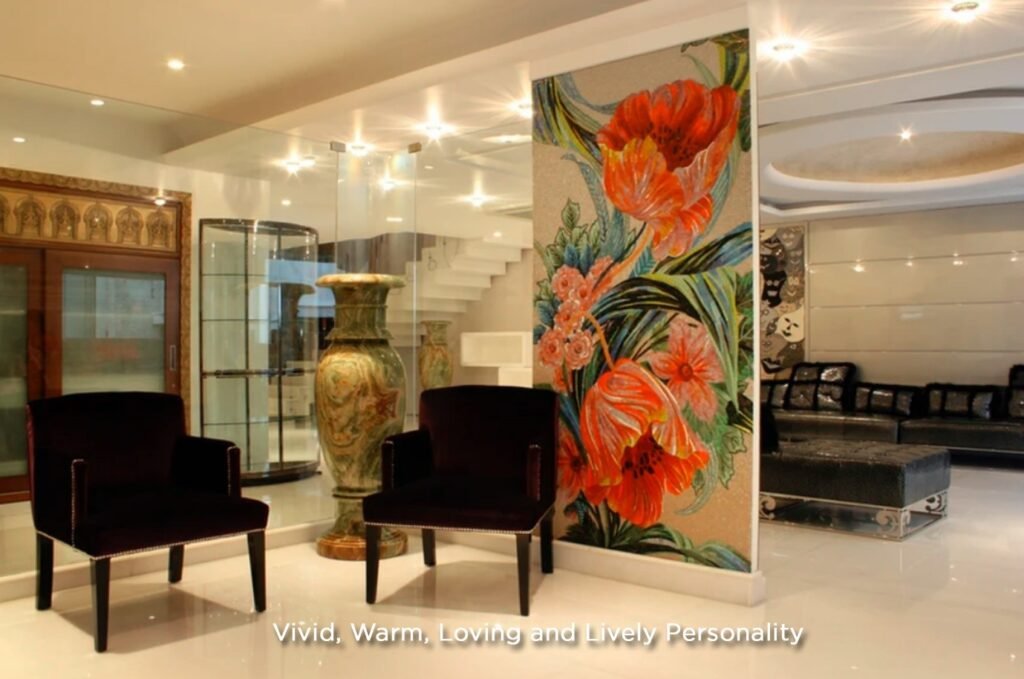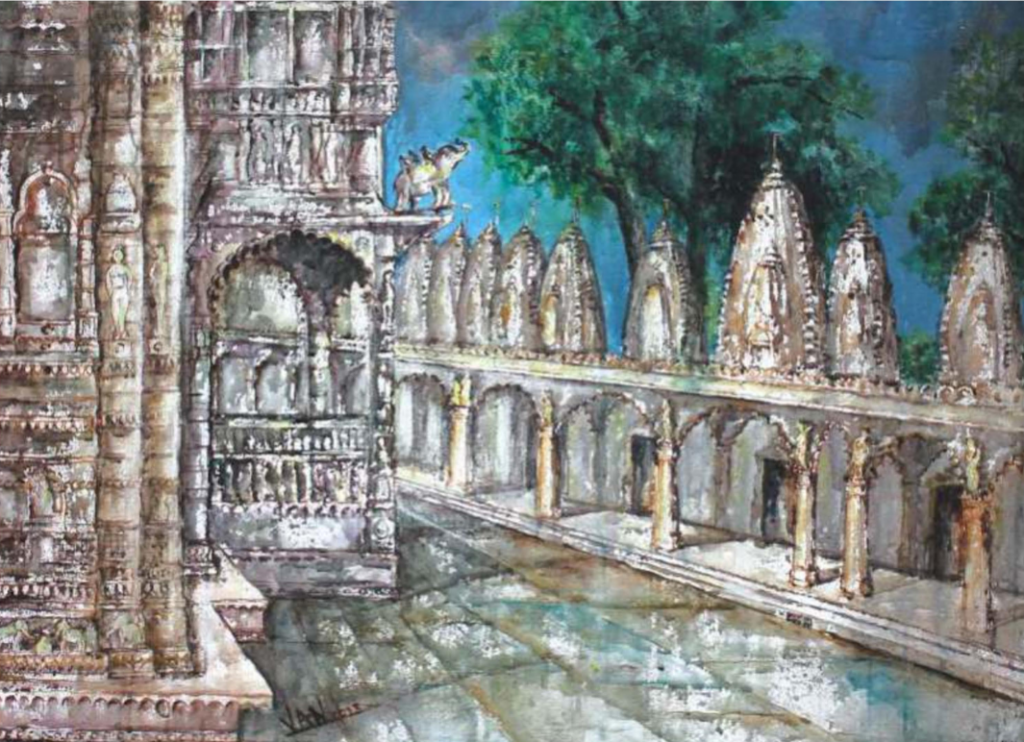In contemporary architecture, the word luxury is often associated with imported stone, glass facades, and the kind of material catalogues that travel farther than most of their occupants. Yet increasingly, architects are reinterpreting luxury not as something shipped across oceans, but as something grown, quarried, or crafted within a few hundred kilometers of the site. …

Table of Contents
- Why Local Is the New Luxury
- Vernacular, Reframed
- Four Pillars of Local Material Performance
- Indian Architects Reclaiming Vernacular Materials
- The Tension: Vernacular vs. Modern Aspirations
- Case Study: Laterite in Kerala
- Case Study: Earth Blocks in Bangalore
- The Global-Local Conversation
- Looking Forward: Local as Future
- Conclusion
In contemporary architecture, the word luxury is often associated with imported stone, glass facades, and the kind of material catalogues that travel farther than most of their occupants. Yet increasingly, architects are reinterpreting luxury not as something shipped across oceans, but as something grown, quarried, or crafted within a few hundred kilometers of the site. This shift, subtle at first, is gaining momentum: local materials, long seen as “ordinary” or “vernacular,” are being reframed as high-performance, sustainable, and deeply luxurious.
From earth walls that breathe to lime plasters that acquire a soft sheen with age, vernacular materials embody qualities that are difficult for industrial substitutes to replicate. For architects, the question is no longer whether these materials belong in contemporary design, but how they can be deployed intelligently without nostalgia, and without compromise.
Why Local Is the New Luxury
Architects often argue that true luxury lies not in expense, but in attention. Local materials are curated with intent: selected for their climate responsiveness, crafted by skilled hands, and detailed to age gracefully. A hand-burnished lime wall that acquires patina over decades speaks more of permanence than a polished imported marble slab that demands constant upkeep.
This reframing of luxury is shaped by three key shifts:
- Scarcity of resources. The 21st century has redefined scarcity. Carbon, not Carrara marble, is the rarest commodity. A wall system that cuts cooling loads by 30% is, in many ways, more valuable than a wall that dazzles with imported sheen.
- Authenticity as aesthetic. Clients today are design-aware. They recognize when a building is “pretending” to be elsewhere. A laterite wall in Kerala or a sandstone jaali in Rajasthan carries the grain and color of its place, just as dialect carries the music of a region.
- Resilience in logistics. Locally sourced materials reduce dependence on fragile global supply chains. When stone comes from 80 kilometers away, schedules are steadier, maintenance simpler, and costs more predictable. At the same time, regional economies benefit turning material choice into a socio-economic decision as well.
Vernacular, Reframed
The word vernacular often conjures images of rustic huts or mud-walled cottages. Yet in practice, vernacular is not about form it is about intelligence. It is climate-smart, resource-aware, and culturally embedded.
Vernacular materials can be grouped into broad families:
- Earth-based systems such as adobe, rammed earth, and compressed stabilized earth block (CSEB).
- Stone including laterite, sandstone, basalt, and granite, each with regional identities and performance characteristics.
- Plant-based materials like bamboo, thatch, or responsibly harvested timber.
- Ceramics and terracotta used for blocks, jaalis, and roof tiles.
- Traditional binders such as lime, surkhi (brick dust), and other pozzolanic additives.
- Reclaimed materials—from roof tiles and timber joists to stone slabs and demolition brickwork.
- Urban vernaculars—where waste streams like fly ash, debris, or quarry overburden are turned into usable building blocks.
Modern vernacular design does not exclude steel, concrete, or glass. Rather, it rebalances their role, letting local and low-embodied-carbon materials carry the structural and environmental weight.
Four Pillars of Local Material Performance
From an architect’s perspective, four criteria guide the specification of vernacular materials:
- Climatic performance. Local materials are often inherently suited to the diurnal temperature swings, humidity levels, and rainfall patterns of their region. A mud wall in arid Gujarat performs thermal mass functions far better than thin concrete panels.
- Carbon and energy. Materials like lime or stabilized earth consume far less energy than Portland cement or aluminum. In lifecycle terms, the carbon savings are dramatic.
- Craft and labor. Vernacular systems engage local skill networks. This ensures not only employment, but also continuity of knowledge, where masons and craftspeople bring generational expertise to modern projects.
- Cultural resonance. Buildings made with local materials “look right” in their contexts. They visually tie architecture to landscape, avoiding the alien quality of facades transplanted from foreign contexts.
Indian Architects Reclaiming Vernacular Materials
Across India, several architects and practices have demonstrated that local materiality is not a compromise but a design opportunity.
- Laurie Baker (though originally British, he worked almost entirely in India) is often called the “Gandhi of Architecture.” His use of exposed brick jaalis, rat-trap bond walls, and locally quarried laterite in Kerala showed how ordinary materials could achieve extraordinary beauty.
- B.V. Doshi, India’s only Pritzker laureate, constantly argued for contextual architecture. His use of stone and brick at the Indian Institute of Management Bangalore blended seamlessly with the climate and culture, setting a precedent for monumental yet humane design.
- Anupama Kundoo has built extensively with ferrocement, mud, and lightweight fillers, showing how traditional materials can merge with modern technology. Her Wall House in Auroville is a case study in integrating terracotta, rammed earth, and ferrocement with elegance.
- Bijoy Jain (Studio Mumbai) approaches material as narrative. From hand-crafted bamboo and brick pavilions to stone houses in Alibaug, his projects highlight the tactility and cultural rootedness of craft.
- Vinu Daniel (Wallmakers) has become synonymous with waste-based vernacular. Using mud blocks, debris, and laterite, his buildings like the Chuzhi House blur boundaries between land and architecture.
- Chitra Vishwanath (Biome Environmental Solutions) has consistently employed earth construction in Bangalore, advocating for water harvesting, passive cooling, and climate-aligned structures.
- Hunnarshala Foundation in Bhuj has worked extensively with communities to rebuild after the 2001 earthquake, reviving mud, thatch, and stone construction in ways that are structurally safe and socially empowering.
Each of these architects demonstrates that local materiality is not only about environmental responsibility but also about creating spatial poetry rooted in place.
The Tension: Vernacular vs. Modern Aspirations
One challenge architects face is perception. For many clients, mud or bamboo still carries connotations of poverty or impermanence. The architect’s task, therefore, is to reframe these materials as aspirational. This involves:
- Detailing for dignity. A rammed earth wall with crisp steel inserts can look more luxurious than imported cladding.
- Hybrid strategies. Combining earth walls with reinforced concrete frames reassures clients while retaining performance.
- Showcasing longevity. Pointing to centuries-old lime-plastered havelis or stone temples provides cultural validation.
The real design challenge lies not in sourcing, but in storytelling convincing stakeholders that local equals premium.
Case Study: Laterite in Kerala
Laterite, abundant across coastal Kerala, was long used for compound walls and modest dwellings. Architects like Laurie Baker and Vinu Daniel reframed it as a noble material. When cut into blocks and left exposed, laterite develops a soft, breathable surface. Paired with terracotta jaalis, it allows ventilation while reducing cooling loads perfect for Kerala’s humid climate. Today, villas built in exposed laterite are marketed as bespoke luxury homes.
Case Study: Earth Blocks in Bangalore
Biome Environmental Solutions has demonstrated how compressed stabilized earth blocks (CSEB) perform well in Bangalore’s moderate climate. By sourcing soil from site excavations and stabilizing it with a fraction of cement or lime, the practice reduces embodied energy, minimizes transport, and achieves a palette of warm textures. For urban clients, CSEB walls detailed with large glazing panels and green roofs present a contemporary yet grounded image.
The Global-Local Conversation
Interestingly, the international design world has begun to look toward India for inspiration. The Venice Biennale, global journals, and academic institutions increasingly spotlight Indian practices that experiment with earth, bamboo, and waste. What was once dismissed as “vernacular” is now reframed as “avant-garde sustainability.”
This shift should embolden Indian architects to lean further into local materiality not defensively, but as leaders of a global dialogue.
Looking Forward: Local as Future
The architecture of the future will not be judged solely on aesthetic or programmatic success. It will be measured by carbon footprints, adaptability, and cultural resonance. In this context, local materials are not simply an option they are a necessity.
An architect specifying laterite instead of imported granite is not just making a material choice; they are making a statement about ethics, resilience, and belonging.
In a world of climate anxiety, local is no longer provincial. It is progressive. It is precise. It is luxurious.
Conclusion
The power of vernacular materials in modern design lies not in nostalgia but in intelligence. By embracing what is available, by working with craftspeople who know the land, and by detailing with contemporary precision, architects can create buildings that are not only sustainable but also deeply desirable.
Indian architects from Laurie Baker to Chitra Vishwanath, from Bijoy Jain to Vinu Daniel have shown that when buildings are grounded in local materials, they acquire a rare quality: they belong.
And perhaps belonging being inseparable from a place is the highest form of architectural luxury.





